Understanding House Crickets: Insights & Management
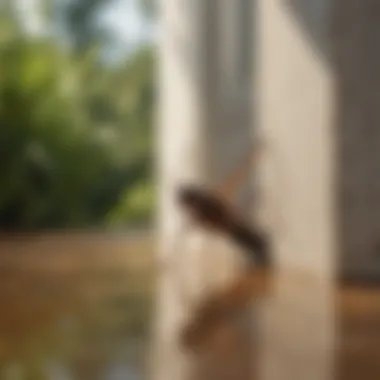
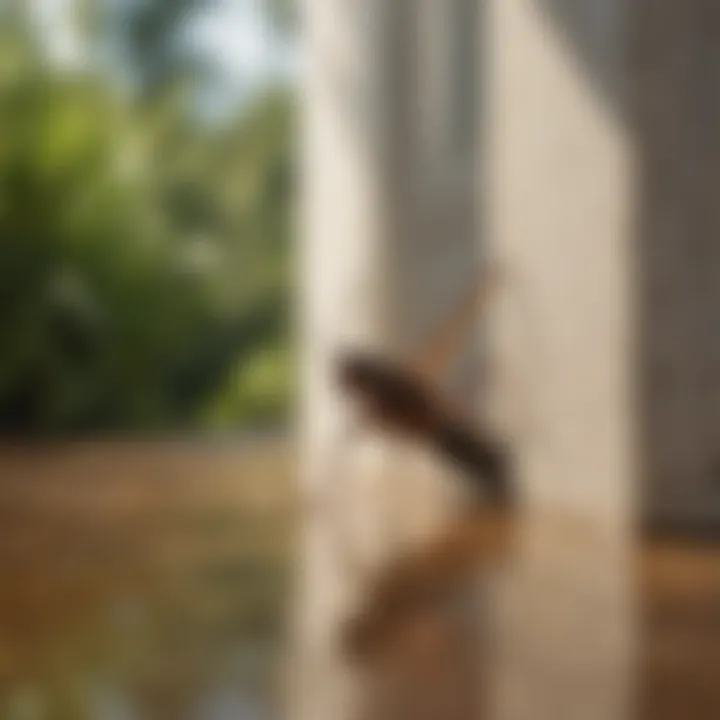
Intro
House crickets are small, brown insects known for their distinctive chirping sound. They often invade our homes, seeking warmth and food. Understanding their presence in residential environments is crucial for homeowners who wish to address the potential challenges they bring.
This article presents a detailed examination of house crickets, their biology, and behavior. We will also explore their ecological roles to provide insights into their importance in our environment. Additionally, we will discuss effective management strategies that align with eco-friendly principles, allowing readers to coexist harmoniously with nature while minimizing any negative impacts. Ultimately, this guide aims to equip homeowners with knowledge for smart and sustainable pest management practices.
Understanding Pests
Definition of Pests
Insects like house crickets are often categorized as pests due to their interactions with humans. Generally, a pest is any organism that negatively affects our well-being, property, or ecological balance. House crickets can cause discomfort and introduce hygiene issues in homes, leading to their classification as pests by many.
Importance of Pest Identification
Identifying pests accurately is the first step in managing them effectively. For homeowners, this means distinguishing house crickets from other similar species. They have long antennae and a somewhat elongated body, with adult crickets reaching about 2 to 3 centimeters in length. Knowing their characteristics assists in the implementation of proper control methods.
Prevention Techniques
Home and Garden Preventative Measures
Preventing house crickets from entering the home is vital. Here are some effective measures:
- Seal Gaps: Inspect windows, doors, and other entry points. Use caulk to fill gaps and keep crickets out.
- Remove Food Sources: Keep food in airtight containers. Regularly clean up crumbs and spills to eliminate attractants.
- Maintain Yard Health: Trim vegetation away from your home. This reduces hiding places for crickets and other pests around your house.
Seasonal Prevention Tips
Different seasons may bring varied concerns regarding house crickets. To prepare for changes, consider the following tips:
- Fall Preparation: As temperatures drop, crickets seek warmth. Apply preventative measures before winter arrives.
- Spring Maintenance: Conduct thorough cleaning to remove winter debris where crickets may breed and hide.
Eco-Friendly Pest Control Solutions
Overview of Sustainable Practices
Sustainable pest management focuses on methods that minimize harm to the environment. For crickets, this includes:
- Encouraging Natural Predators: Birds and certain insects can help keep cricket populations in check. Consider creating a garden environment that attracts these natural enemies.
- Physical Barriers: Using screens and traps can deter crickets without the need for chemicals.
Natural Remedies and Their Effectiveness
Several natural remedies can mitigate house cricket infestations. Here are some to consider:
- Essential Oils: Certain oils such as peppermint and eucalyptus can deter crickets when sprayed in areas where they are found.
- Diatomaceous Earth: This powder, made from fossilized algae, can be spread in areas where crickets gather, causing dehydration and death.
"Understanding the biology and behavior of house crickets allows for more effective management solutions."
By utilizing these natural methods, homeowners can approach cricket management with environmental consciousness. This fosters a respectful coexistence with these insects while addressing concerns effectively.
Preface to House Crickets
House crickets are more than just a common insect found in many residences; they represent a fascinating component of our indoor environments. Understanding them is vital for homeowners, especially those who wish to maintain a harmonious living space while acknowledging the presence of these creatures. The significance of house crickets extends beyond mere annoyance; they play roles in ecosystems and may indicate larger environmental conditions.
Defining the House Cricket Species
The house cricket, scientifically known as Acheta domesticus, is a species that has adapted well to human environments. Generally, they are about 3 to 4 centimeters long and have a brownish color. Their distinguishing features include long antennae and long hind legs, which they use for jumping. One notable aspect is their chirping, which is a mating call produced by males to attract females.
House crickets are widely distributed across various regions, particularly in temperate climates. They thrive in warm places, such as homes, barns, and greenhouses. However, they can also be found outdoors during warmer seasons. Their ability to reproduce quickly makes them a common sight, especially if conditions are favorable.
Historical Context of House Crickets
House crickets have a long association with humans, dating back several centuries. Originally, they are thought to have been native to Asia, specifically parts of the Middle East. As people started to trade more widely, they spread to Europe and eventually to the Americas. Their presence was often seen as a sign of poor sanitation, given their behavior of infesting homes in search of food and warmth.
Historically, these insects have also held cultural significance. In some cultures, crickets symbolize good luck, while in others, they are regarded as food. Today, the understanding of their role in our ecosystems has evolved. Studies show that house crickets contribute to nutrient cycling and serve as prey for various predators. This historical context adds depth to our understanding, which is essential for effective management and coexistence.
Biology of House Crickets
Understanding the biology of house crickets is crucial for recognizing their roles in our homes and the environment. Knowing how they grow, reproduce, and what they look like helps homeowners manage potential infestations. Biology offers insights into the life stages and physical traits of these insects, allowing for more effective control measures.
Life Cycle Stages
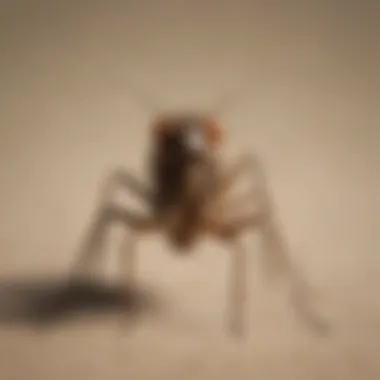
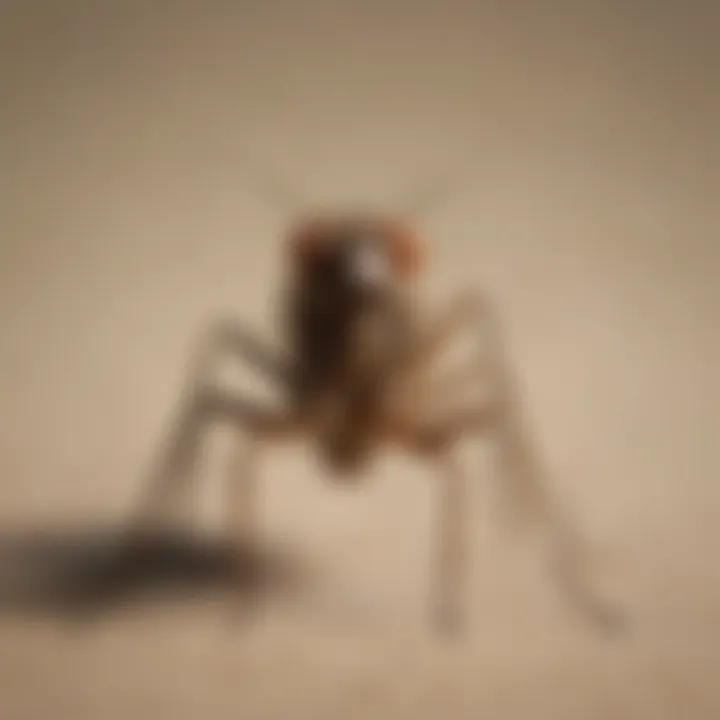
House crickets undergo a simple metamorphosis consisting of three stages: egg, nymph, and adult. Each stage plays an essential role in understanding their population dynamics.
- Egg: Female crickets lay eggs in batches of about 20 to 50. These eggs typically appear in moist places, often in soil or decaying plant matter. They can survive through winter in this stage.
- Nymph: After about two weeks, the eggs hatch into nymphs. The nymph stage is increasingly mobile, and they resemble smaller adults, lacking wings. They molt several times, growing each time until they reach adulthood, which can take a few months.
- Adult: Once nymphs mature, they develop wings and reproductive capabilities. Adult crickets are more vocal, with males producing chirping sounds to attract females. Understanding these stages enables more targeted pest control measures, as interventions can be specifically aimed at vulnerable life stages.
Physical Characteristics
House crickets have distinctive physical traits. Their appearance helps in quick identification and also influences their behavior.
- Size: Adults are typically about 1 to 1.5 inches long, making them noticeable but not overly large.
- Color: They are generally brown or yellowish-brown, with a darker brown coloration often observed.
- Wings: Though adults have wings, they are not strong flyers, primarily using them for short jumps.
- Antennae: Their long, thread-like antennae can be up to twice their body length, helping them sense their environment.
Recognizing these characteristics helps individuals distinguish house crickets from other insect species, which is key in effective management strategies.
"Understanding the biology of house crickets not only assists in identification but also informs effective management practices."
Cricket Behavior and Ecology
The behavior and ecology of house crickets hold significant relevance in understanding their role within residential settings. This section delves into various aspects of their feeding habits, mating rituals, and habitat preferences. Each of these elements contributes to their survival and the potential challenges they may pose to homeowners. By grasping these insights, we can foster a more effective approach to managing their presence while respecting their ecological contributions.
Feeding Habits
House crickets exhibit diverse feeding habits, allowing them to thrive in various environments. They are omnivorous, consuming a wide range of organic matter. Their diet mainly consists of plant-based materials, including grains and vegetables, as well as other insect bodies. This adaptability in feeding not only ensures their survival but also underscores their potential to affect garden vegetation.
Crickets tend to feed at night, making them nocturnal creatures. Their tendency to attract moisture may lead them to gravitate toward damp areas in the house, such as basements or kitchens. Understanding their feeding patterns can aid homeowners in identifying potential infestation sites early on. Addressing these areas with proper sanitation measures can diminish food sources, thus discouraging crickets from taking up residence.
Mating Rituals and Sounds
Mating rituals among house crickets are particularly fascinating. Male crickets are known for their distinctive chirping sounds, which play a crucial role in attracting females. The sound is produced by rubbing their wings together in a process known as stridulation. This behavior not only signifies presence but also indicates health and fitness, critical factors for female selection.
The constant evolution of their mating calls presents implications for ecological balance. The calls can become a nuisance for homeowners, especially during active seasons. Recognizing these behavioral patterns can help individuals manage the situation more effectively. It is also noted that the volume and frequency of these calls can be influenced by environmental factors, such as temperature and humidity, enhancing understanding of their mating dynamics under specific conditions.
Habitat Preferences
House crickets demonstrate adaptable habitat preferences. They tend to favor warm, dark, and humid locations, which provide appropriate conditions for their development. Common hiding spots include basements, attics, and cracks within walls. This choice of habitat is not merely random but rather a survival strategy that shelters them from predators and environmental stresses.
Homeowners should strive to minimize the availability of such preferred habitats. Sealing entry points, removing clutter, and ensuring proper ventilation can diminish nesting opportunities. By understanding where crickets are likely to establish their homes, proactive measures can be taken to create less hospitable conditions. Furthermore, maintaining a clean and dry environment discourages these insects from lingering.
Effective management of house crickets relies on understanding their behavior and ecological needs. This knowledge enables homeowners to implement strategies that not only mitigate infestations but also maintain a respectful relationship with the nature around them.
Identifying an Infestation
Identifying the presence of house crickets in your living space is crucial for effective management. Early detection allows homeowners to take appropriate measures before an infestation escalates. Understanding the signs of cricket presence and distinguishing between species can help in selecting suitable intervention strategies. Moreover, recognizing an infestation aids in mitigating potential damages to property and enhances overall cleanliness in the home.
Signs of Cricket Presence
There are several noticeable indicators that may suggest the presence of house crickets in your home. These include:
- Auditory Clues: The most common sign is the distinctive chirping sound produced by male crickets searching for mates. This sound can be quite loud and is a telltale sign of their presence.
- Physical Sightings: Spotting crickets themselves is an obvious sign. They are typically brown or tan, about ¾ inches long, with long antennae. Their shape and colour can help identify if they are indeed house crickets.
- Droppings: Small, cylindrical droppings found in areas like corners or cupboards can indicate their presence. These droppings resemble black pepper and signify a larger cricket population.
- Damage: Look for signs of damage to fabrics, paper, or even food items. House crickets feed on a wide range of materials, and chewed items can signify their feeding habits.
By paying attention to these signs, homeowners can act promptly and effectively.
Differentiating Between Cricket Species
It is essential to identify which cricket species is present in your home to tailor your management approach effectively. The house cricket (Acheta domesticus) is the most commonly found species in residential areas. However, other species like field crickets or tree crickets may also invade homes.
To differentiate:
- Size and Color: While the house cricket is about ¾ inches and typically brown, field crickets are larger and darker. Yard crickets are green or brown and might look different from house crickets.
- Songs and Calls: Male crickets have unique chirping patterns. House crickets produce a short, continuous trill, while field crickets create a more varied and intermittent sound. Identifying these calls can help in distinguishing them.
- Habitat Preferences: House crickets prefer warm, moist environments, often indoors. In contrast, field crickets are typically found in moist soil outdoors. Understanding where you spotted them can provide clues to their species.
Knowing the species helps in choosing the correct management options and understanding their behavior and needs more thoroughly.
"Early identification of cricket infestations is not just about eradication but understanding behavior for future prevention."
Tracking the signs of presence and being able to identify different cricket species contributes greatly to sustaining a comfortable living environment.
Potential Threats Posed by House Crickets
Understanding the potential threats posed by house crickets is critical for homeowners. These insects are not just mere nuisances; they can lead to significant concerns regarding property damage and health risks. Identifying these threats early helps in mitigating their impact and taking necessary preventive measures.
Damage to Household Goods
House crickets have a notorious reputation for causing damage to household items. They primarily feed on organic materials, which include fabrics, paper, and even some plastics. This can lead to a variety of concerns:
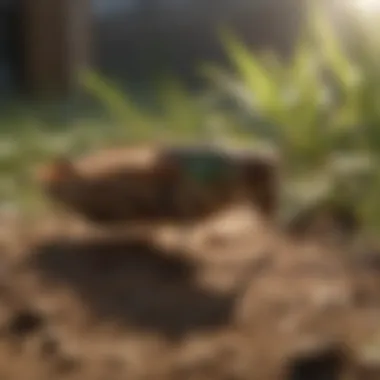
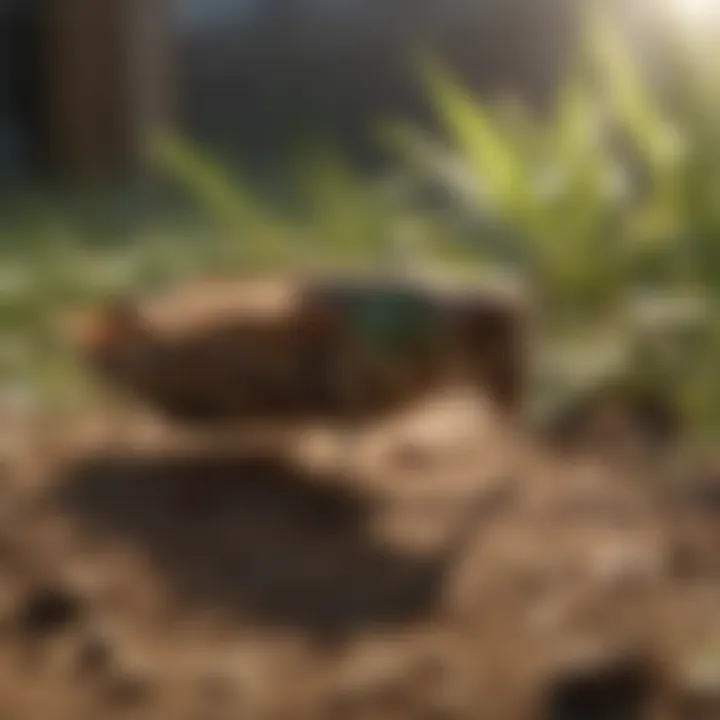
- Textiles: Fabrics made from natural fibers, such as wool and cotton, are especially vulnerable. Crickets may gnaw on clothing, curtains, and carpets leading to unsightly holes and weakened materials.
- Paper Products: Important documents such as books and agreements may be damaged if crickets infest a space. This poses risks, especially for those who rely on these items for personal or professional matters.
- Stored Food: While house crickets are not known to infest food directly, their presence can attract other pests, leading to potential contamination and spoilage. Therefore, maintaining cleanliness is essential.
Taking steps to inspect and protect these items is crucial for maintaining the integrity of one's household. Regular cleaning and careful storage of items prone to damage can prevent the costly repercussions of an infestation.
Health Implications
Beyond property damage, house crickets can present health risks to inhabitants. Although they are not known to transmit diseases directly, their presence can lead to several indirect health concerns:
- Allergies: Some individuals may have allergic reactions to cricket bites or their droppings. This can manifest as respiratory problems or skin irritations, particularly for those with preexisting sensitivities.
- Contamination: By invading living spaces, crickets can contribute to unsanitary conditions. Their feces, which may contaminate food or surfaces, pose potential health risks to humans and pets.
- Complications with Other Pests: The presence of house crickets may attract predators that can be harmful, such as spiders or rodents, which can further complicate health and safety issues in the home.
In summary, understanding the potential threats of house crickets goes beyond nuisance control. By recognizing how they can damage belongings and pose health risks, homeowners can take better preventive measures. Being proactive will ensure a safe and healthy living environment.
Ecological Roles of Crickets
The ecological roles of crickets, specifically house crickets, are often overlooked in discussions about pest management. However, understanding these roles can enhance our appreciation for their presence in our environment. House crickets play significant parts in their ecosystems, contributing towards various ecological functions that benefit both nature and human habitation.
Crickets in the Ecosystem
House crickets act as both prey and scavengers, filling essential niches within their habitat. As prey, they provide food for a variety of animals, including birds, reptiles, and small mammals. This predatory relationship helps maintain the balance of ecosystems. Without crickets, some species might struggle to find adequate nourishment, ultimately disrupting the food web.
Moreover, crickets contribute to nutrient cycling through their feeding habits. Their consumption of organic matter, such as decaying plants and other decomposing materials, helps break down these substances. This process fosters soil fertility and promotes healthy plant growth. By assisting in decomposition, house crickets play a crucial role in maintaining the health of their habitats.
Contribution to Biodiversity
Crickets, including house crickets, are vital to biodiversity and the overall stability of ecosystems. They are part of various food chains, helping to sustain diverse species within their environments. The presence of these insects contributes to the richness of wildlife; their absence could lead to reduced species variety in the ecosystem, indicating their importance.
Additionally, the adaptability of house crickets allows them to thrive in various habitats, from forests to urban settings. This adaptability highlights the vigor of their species and underscores their resilience in fluctuating environments. Crickets can contribute to a balanced ecosystem by living harmoniously alongside other species, both flora, and fauna.
Crickets are more than just pests; they serve as a vital link in the web of life, sustaining ecosystems and supporting biodiversity.
Prevention Strategies
Preventing house cricket infestations is a crucial aspect of effective pest management. By employing various strategies, homeowners can reduce the chance of these insects encroaching into their living spaces. Prevention focuses on creating an environment that is less conducive to cricket habitation, thus minimizing the risks associated with their presence.
Environmental Management Techniques
The environment plays a significant role in attracting house crickets. Taking steps to modify this environment can greatly deter these pests. Some techniques include:
- Reducing Moisture: Crickets thrive in humid conditions. Keeping areas like basements and kitchens dry is essential. Use dehumidifiers in areas prone to moisture.
- Decluttering: Clutter provides hiding spots for crickets. Regularly clean and organize your home, removing unnecessary boxes or materials that can serve as nesting areas.
- Landscaping Considerations: Maintaining a well-trimmed yard can discourage crickets from settling nearby. Overgrown bushes and tall grasses can attract them closer to your home.
- Lighting Adjustments: Crickets are attracted to light. Using yellow-toned bulbs can reduce attraction to your home, especially near entrances.
Implementing these strategies can create a less inviting space for crickets. These methods are often low-cost yet significantly effective.
Home Repairs and Maintenance Tips
Maintaining your home's structure is vital for keeping house crickets at bay. Certain repairs and maintenance tasks can help seal entry points and restrict their access:
- Sealing Cracks and Gaps: Inspect your home for any cracks in walls or gaps around doors and windows. Use caulk or weather stripping materials to seal these openings tightly.
- Fixing Screens: Ensure that all window and door screens are intact and free from holes. This simple repair can greatly reduce the chances of crickets entering.
- Maintaining Plumbing: Check for leaks or standing water. Repairing leaks and ensuring proper drainage can decrease humidity levels in the home, making it less favorable for crickets.
- Regular Inspections: Conduct periodic checks of your home for signs of potential entry points for crickets. Early detection is key.
These practices not only enhance the integrity of your home but also contribute to a healthier living environment. A proactive approach to home repairs can significantly mitigate the risk of infestations.
"An ounce of prevention is worth a pound of cure." By taking measures now, homeowners can save themselves from potential problems later on.
Eco-Friendly Management Techniques
Adopting eco-friendly management techniques for house crickets serves as a crucial component in the overall understanding of their presence and control measures within residential environments. As house crickets inhabit spaces where humans also dwell, it is essential to explore methods that address their presence without detrimental effects on the ecosystem. Such strategies promote a balance between managing unwanted pests and maintaining a healthy coexistence with nature.
The main benefits of eco-friendly techniques include reducing chemical usage, safeguarding human health, and protecting non-target species in the environment. Unlike conventional methods that may result in adverse consequences to beneficial insects, natural deterrents and mechanical solutions provide effective alternatives. Homeowners can implement these strategies with minimal environmental impact, which is increasingly becoming important in today’s ecological landscape.
Considerations regarding eco-friendly techniques also emphasize the necessity for ongoing education and awareness. Homeowners must remain informed about the implications of various management approaches to ensure they are making the most suitable choices for their households and for the environment.
Natural Deterrents
Natural deterrents are substances derived from the environment that help to repel house crickets without the use of harmful chemicals. Common natural deterrents for house crickets include:
- Essential oils: Ingredients like peppermint oil or eucalyptus can be effective. Applying these oils diluted with water around entry points can discourage crickets from entering.
- Diatomaceous earth: This is a natural powder made from the remains of tiny aquatic organisms. Sprinkling it in areas where crickets are noticed can deter them from making those spots their habitat.
- Vinegar sprays: A simple combination of vinegar and water can serve as a repellent when sprayed in places frequented by crickets.
Using these natural deterrents can help create a less inviting environment for house crickets while supporting a healthier ecosystem. These methods also promote safer living conditions for children and pets since they are typically non-toxic.
Traps and Mechanical Solutions
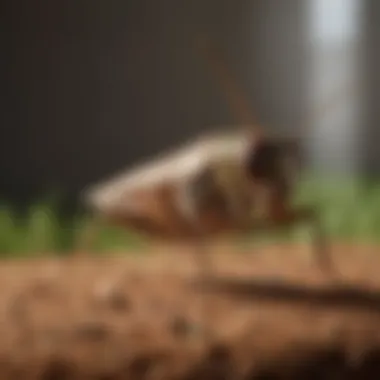
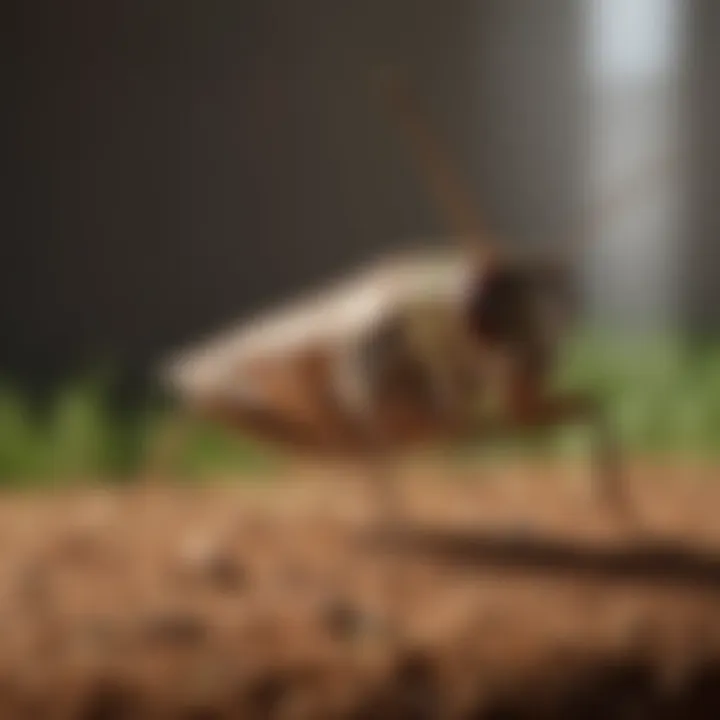
Traps and mechanical solutions offer homeowners a practical method for controlling house cricket populations effectively without harming the environment. These methods range from simple homemade traps to commercially available mechanical solutions. Here are a few effective strategies:
- Sticky traps: These traps can be placed in areas where crickets are commonly found. They are non-toxic and capture crickets without causing harm to other species.
- Homemade water traps: Filling a shallow container with water and a few drops of soap can entice crickets. The soap reduces the surface tension, preventing them from escaping.
- Light traps: Crickets are nocturnal and attracted to light. Placing light traps outside can help divert them away from homes and into controlled areas.
These traps and mechanical solutions prune down cricket populations without relying on chemical pesticides, rendering them crucial in any eco-friendly management strategy. By effectively utilizing these approaches, homeowners can maintain their living spaces free from crickets while respecting ecological principles.
Chemical Treatments and Considerations
Understanding the various chemical treatments available for managing house cricket populations is vital for homeowners. Insecticides serve as a primary method in controlling these pests, especially when other management strategies have been ineffective. However, there are important considerations that come with their use. Their effectiveness, when applied correctly, can lead to significant reductions in cricket populations, providing relief for affected households.
Using insecticides requires a comprehensive understanding of the product itself. Homeowners should consider the active ingredients and their effectiveness against house crickets. Not all insecticides are created equal. Some are designed specifically for crickets while others target a broader spectrum of pests. The choice of insecticide should not only be based on its killing capabilities but also on its safety for humans and pets.
Best Practices for applying insecticides include:
- Read the Label: Always follow the instructions provided by the manufacturer. Misapplications can result in ineffective treatments.
- Selective Application: Apply insecticides in areas where crickets are most likely to inhabit. Common locations include basements, attics, and areas around entry points.
- Timing: Consider the life cycle of house crickets. Attacking during peak activity times can enhance effectiveness, especially at night when crickets are most active.
- Personal Safety: Use protective gear, such as gloves and masks, to minimize exposure during application.
Regular monitoring after treatment is essential. Homeowners should observe the treated areas for changes in cricket activity. If no improvement is seen within a few days, it may require a reevaluation of the treatment approach.
"Proper use of chemical treatments can dramatically reduce house cricket populations, but safety must always come first."
Impact on Non-target Species
When choosing chemical methods for cricket control, the impact on non-target species needs careful consideration. Insecticides often affect a wide range of other insects and can disrupt local ecosystems. For example, many beneficial bugs, such as bees and ladybugs, may be harmed inadvertently. Households must weigh the benefits of controlling house crickets against the potential collateral damage to these non-target species.
Impacts can include:
- Disruption of Food Chains: Killing beneficial insects can unbalance local biodiversity, affecting larger species that rely on those insects for food.
- Long-term Effects: Over-reliance on chemical treatments may lead to resistance in cricket populations. This could necessitate the use of stronger, more harmful chemicals over time.
- Environmental Concerns: Chemical runoff can lead to water contamination, affecting aquatic ecosystems and wildlife.
In summary, while chemical treatments can provide effective short-term solutions for managing house crickets, the long-term consequences for the environment and non-target species must be considered. Homeowners should always look for a balanced approach that includes ecological perspectives.
Community Perspectives on Crickets
The topic of community perspectives on crickets reveals much about how society views these insects and their role in our lives. Understanding the cultural and social implications of house crickets can enhance awareness and promote better management strategies. This section highlights different aspects of how people relate to crickets, emphasizing their cultural significance and the need for public education.
Cultural Significance of Crickets
Crickets have held various meanings in different cultures throughout history. In many regions, they are considered symbols of good luck. For example, in China, crickets are seen as pests, but also as creatures of beauty and melody. Their song is thought to bring fortune and prosperity. In certain parts of Asia, crickets are bred for their sounds, which are appreciated during the fall season. This cultural appreciation extends to their representation in art and literature, where they symbolize resilience and connection to nature.
This dual perception can influence how homeowners approach the presence of crickets. While they may be unwelcome guests in some situations, their cultural roles can foster respect for nature. Residents might find themselves torn between a desire to keep their homes cricket-free and a recognition of the insect's broader ecological value. Thus, acknowledging the cultural significance of crickets can guide eco-friendly management decisions and foster a balanced relationship between people and these insects.
Public Awareness and Education
Public awareness is crucial in reshaping perceptions about house crickets. Many people view these insects purely as pests, often without understanding their ecological roles or their historical significance. Educational campaigns can bridge this gap, bringing understanding to homeowners about the actual impact of crickets on household environments and gardens.
Educating the public can include information about:
- The benefits of maintaining a natural ecosystem that includes crickets.
- Identifying crickets versus other insects.
- Understanding their behavior and life cycle, which can aid in better management.
By fostering an informed public, we can encourage more thoughtful discussions about cohabiting with crickets. Knowledge about alternative pest control methods and their implications can reduce knee-jerk reactions to infestations, leading to more sustainable solutions. In the end, promoting public awareness and education about crickets enhances both coexistence and recognition of the insect’s impact on our homes and gardens.
"Understanding the ecological significance of house crickets can transform our perspective from seeing them solely as pests to valuable members of our ecosystem."
In summary, addressing community perspectives on crickets is an essential aspect of managing their presence in our homes. Acknowledging their cultural importance and promoting public awareness can foster a more harmonious relationship between humans and crickets.
Finale and Final Thoughts
In the quest to manage house crickets effectively, understanding their biology, behavior, and ecological significance provides a solid foundation. This article has explored various aspects of house crickets, illustrating their complex relationship with humans. The key lies in recognizing the balance between coexistence and management. House crickets are not just pests; they serve as vital components in our ecosystem.
By grasping the core insights about cricket behavior and ecology, homeowners can make informed decisions on management strategies. The implications of neglecting these insects can lead to unnecessary harm to both the environment and household goods. Thus, a thoughtful approach is essential.
Additionally, fostering awareness within the community about the role of crickets can shift perceptions from mere annoyance to understanding their ecological contribution. This holistic view empowers individuals to take appropriate action while respecting the natural world.
Recap of Key Insights
The exploration of house crickets in this article has unveiled several insights:
- Biology and Behavior: Understanding the life cycle and habitat preferences of house crickets clarifies why they invade living spaces.
- Impact on Households: The potential damage they cause to goods and the health implications associated with infestations stress the need for management.
- Management Techniques: Effective strategies, both eco-friendly and conventional, offer solutions that fit various situations.
- Community Awareness: Education plays a crucial role in how people view and manage these insects.
Highlighting these issues aids homeowners to tackle cricket problems more effectively, transforming a challenge into an opportunity for coexistence.
Future Directions in Cricket Control
Looking ahead, several directions can enhance our approach to cricket management:
- Research on Eco-Friendly Solutions: Expanding studies into natural deterrents could offer improved methods for controlling cricket populations while minimizing ecological impact.
- Community Programs: Increasing awareness through workshops or community initiatives can help individuals better understand crickets and their roles, fostering a sense of responsibility toward management.
- Integration of Technology: Utilizing modern pest control technologies, including app-based monitoring systems, could streamline the detection and management of cricket infestations.
- Sustainable Practices: Encouraging practices that reduce habitat suitability for crickets while maintaining ecological balance is vital for long-term management.
By embracing these future directions, we can foster a more sustainable and informed approach to dealing with house crickets, ensuring their ecological roles are respected while effectively managing their presence in our homes.



